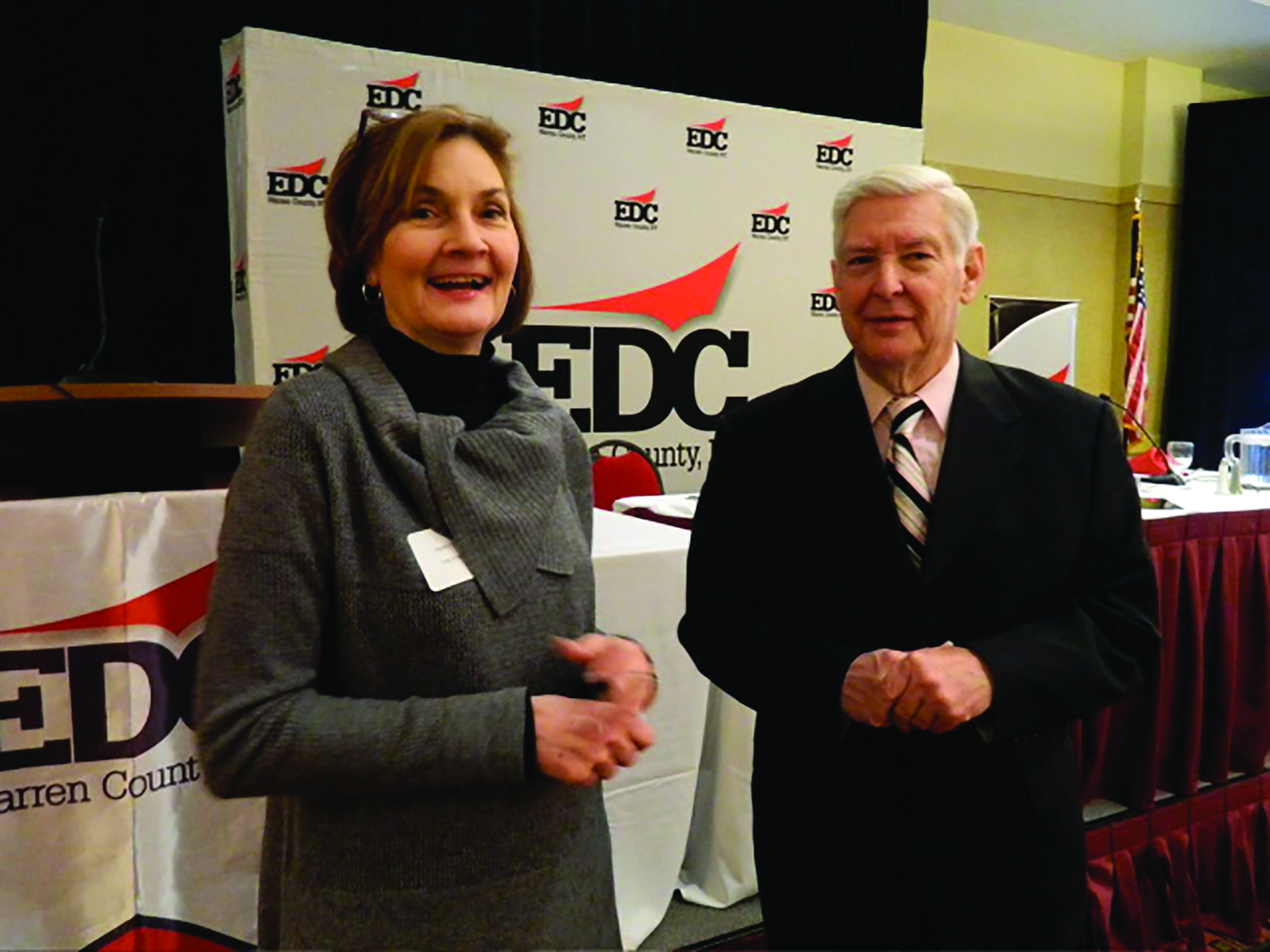
BY LISA BALSCHUNAT
Panelists from the sectors of higher education,
banking, manufacturing and media offered
perspectives on the future of commerce and
development in the region at the Warren Counthy
EDC’s outlook breakfast on Jan. 30 at the Great
Escape Lodge in Lake George.
Kristine Duffy, Ed.D., kicked off the discussion
stating that higher education has received much
attention over the past 10 years.
“Higher education is helping to develop individuals
to be contributors in their community,”
she said. “By 2025, 60 percent of the jobs available
will require secondary education.”
She said SUNY Adirondack, the only college in
Warren County, is diligently working to provide
students with degrees that will meet future needs
in the job market.
The college offers Massive Online Open
Courses (MOOCS), Duffy said. “Most students
participating in MOOCS already have a higher
degree. The curriculum is self paced, competency
based, free online education.”
She said the number of graduates is down in
Warren County by 19 percent; Washington County
by 17 percent and Saratoga County by 1 percent.
College enrollment is down due to the rise during
the recession years and there was a slight decline
in the number of graduates, however Duffy said
SUNY Adirondack is working to bring more fouryear
degrees to campus, similar to its partnership with SUNY Plattsburgh.
Duffy said one of her greatest concerns is that
the state and federal funding to SUNY. “We want
more people to complete degrees and increase
workforce readiness here.”
Tom Murphy, CPA, president and CEO of Arrow
Financial Corp. and Glens Falls National Bank
and Trust Co., spoke about community banking
among its 38 branches and four insurance
companies.
“It was a good year for Arrow Financial Corp.,”
he said. “We continue to expand south with our
loan and banking branches associated with
Saratoga National Bank. Our latest branch is on
New Karner Road in Colonie.”
Murphy said loans and investment banking are
economic drivers.
“They allow businesses to expand, grow and
take on new employees. Our relationship with
customers is changing because customers now
want banking on their terms..”
Murphy said, “Our relationship with our
customers will still be strong to assist them with
their business goals and personal banking needs.”
Terry Coomes, new publisher of the Post-Star,
gave a synopsis of how the newspaper industry
was forced to adjust and work under a new business
model over the past two decades due to the
evolution of the Internet.
“We used to deliver news one time a day, in
the morning at your doorstep,” she said. “Now, we offer news on multiple platforms – on your
desktops, laptops, tablets and mobile devices.”
Coomes, who has been in leadership roles in
the newspaper business since 2006 said print
news is no longer a sustainable business.
“It was critical the business model change for
our survival,” she said. “We have to tell the news
and stories better and in different ways.”
“We are in real time. We know what people are
watching and what they are searching for,” she
added. “The internet changed the newspaper
world.”
Joseph DeVivo, president and CEO of AngioDynamics,
said his company has entered 2015 with
both support and obstacles that keep the medical
device industry in our area moving forward.
He said he appreciates the support of college
and universities in the region that will provide
STEM minds (Science, Technology, Engineering
and Mathematics) that are greatly needed to
compete in the world of medical devices.
“Decisions made by our elected officials shape
some of our business decisions,” he stated. “As
an industry, we need to make health care more
efficient. Data will change health care. Drug
therapies will change health care. Major acquisitions
will change health care. There are massive
inefficiencies that need to be addressed, and us
reducing our product by a dollar or two won’t fix
a system that is broken. There is much to be done
in this industry.”
He said medical devices represents 6 percent
of the health care industry, and that 40 percent
of the labor in the U.S. is in health care.
“We are driving innovative technology, improving
patient outcome and reducing health
care costs by performing at the upper end of our
capabilities,” DeVivo said.
“This year, we are competing with the ‘big guys’
for contracts. We are excited about the future.
We are consolidating our four local facilities
into global distribution and manufacturing with
a finished clean room,” said DeVivo. “The more
profitable we are, the more we can invest …
We have to pay the federal medical device tax
on revenue, not income. That is something we
will soldier through, ” he stated. “We continue to
learn how to talk to the FDA (U.S. Food and Drug
Administration), and will continue to acclimate
to the issues facing our industry to continue to
provide products people need and local jobs to
those in our community.”
Photo by Lisa Balschunat
